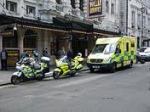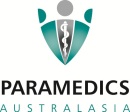One of the first posts written in the early days of the AV blog was about the effectiveness of motorcycle conspicuity and markings during emergency response. A major part of that discussion was concerned with a growing trend in the UK to affix a modified pattern of Battenburg markings onto Police motorcycles . The fluorescent yellow and blue reflective chequered marking pattern was introduced by signwriting firms in the UK who re-configured the earlier Full Battenburg design affixed to police sedans to fit the compact size and curves of the nation’s emergency response motorcycles. This new hybrid livery, rather than enhancing police motorcycle conspicuity, actually decreased conspicuity by introducing serious camouflage effects which easily break up the outline and form of the motorcycle.
The initial conspicuity research undertaken by the Home Office recommended…”a twin chequer band of retro-reflective blue livery film should be applied to the sides of the fairing and to the rear of the bodywork or panniers, depending upon the model of motorcycle. The blue panels should measure 50 mm by 50 mm. It is also acceptable to use panels that measure 100 mm long by 50 mm.” This was a simple two line chequed pattern running horizontally across the fluorescent green-yellow fairings – see image at right. The study recommended the motorcycle and rider should present a unified block of fluorescent yellow-green which was also reflective at night. The London Ambulance Service later removed all the chequered bands from their motorcycles, leaving only a small NHS logo and small LAS text printed on the solid yellow-green base colour (RAL 1016). LAS has since returned to the original Home Office layout with narrow twin green chequer bands. The LAS motorcycle livery is without doubt, a worldwide ‘best practise’ marking scheme.
Solid colour vs camouflage pattern – here is an image which clearly shows the difference in conspicuity and visibility between the motorcycle in front wearing modified Battenburg chequers and a second LAS motorcycle (behind) painted in a solid fluorescent yellow-green livery. The modified Battenburg pattern breaks up the outline and contours of the front motorcycle. This makes the Battenburg bike more difficult to find and slower to define or recognise than the single coloured motorcycle.
The ability of any emergency service motorcycle to be quickly seen & recognised makes an important contribution to the riding officer’s safety during an emergent response or later after arrival when the bike is parked on the roadside at the incident scene. Any increased level of visibility safety flows to members of the public who are less likely to miss seeing the motorcycle and then later go on to be involved in a near miss or a serious accident with the motorcycle.
Clearly, emergency agencies using motorcycles around the globe need to carefully consider their choice of livery colour, pattern and the overall layout of the markings displayed on their bikes. Research, rather than personal preference or ad agency bravado should be the guiding light when it comes to maximizing the conspicuity and visibility of their staff and vehicles.
More information is available on the Ambulance Visibility website or in the Motorcycle Conspicuity section of the AV Reference Library









